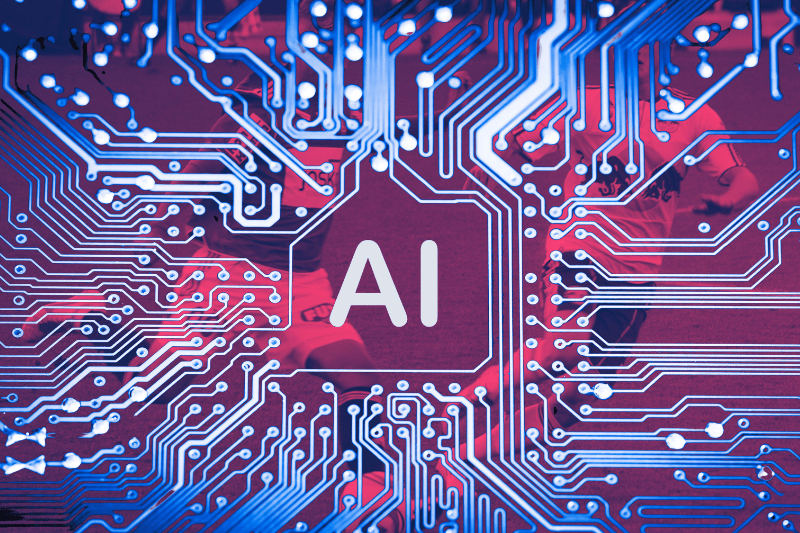
Artificial intelligence is altering the way fans interact with sports, as well as how leagues and rights holders produce data-rich content. Let’s delve further into the game-changing technology's boundless potential. Sports are, at their core, physical endeavors: competitions between athletes that play out on a well-manicured lawn or a freshly waxed court.
This will never change. What we witness unfolds in front of our eyes, be it college sports to the World Cup or the Olympics. Sports inspire us to realize what literal heights humans can achieve while leaving us yearning to participate in those games as never before. As spectators, we may not be able to play at a high level, but we want to be as involved in the details as possible.
 Over the years, we have perfected the spectator experience. We have worked hard to create data that will help us easily comprehend every facet of the games we like by documenting what we experienced in person. First, as a newspaper scoreline, then by radio and the early stages of data capturing with statistics, then a video broadcast, and then more sophisticated data monitoring. Across all levels of sport, there is a desire to convert the physical match into a complete digital record of each game.
Over the years, we have perfected the spectator experience. We have worked hard to create data that will help us easily comprehend every facet of the games we like by documenting what we experienced in person. First, as a newspaper scoreline, then by radio and the early stages of data capturing with statistics, then a video broadcast, and then more sophisticated data monitoring. Across all levels of sport, there is a desire to convert the physical match into a complete digital record of each game.
Sports today rely heavily on statistics. From coaches to players, sports data feeds have a huge effect on-field performance, and they even help match officials monitor and manage the game, enhancing spectators' ability to interact with the sport and enjoy the action.
While properly gathering data is an important first step, the ability to translate it into the sport's precise language, and insights is what unlocks true value. Unfortunately, in many contests today, this value is not realized because data is siloed, not synchronized properly, or not supplied to the market in a readily usable format.
With AI, sports organizations and partner companies may now access a live parallel digital match that mimics what is happening on the actual surface. Every foot movement, every foul, and even the strength of the kick may now be quickly duplicated in the digital realm. Fans will have the opportunity to enjoy all of this in a variety of ways, including statistics, stories, broadcast TV, augmented streams, and AR/VR experiences. But it doesn't stop there. Once digitized, all of this data may be transmitted back and used to augment the player's performance on the field.
When the ball goes out of bounds, possession is determined immediately. When an offside call or a suspected foul tackle occurs, an official is immediately notified. Head coaches may monitor game patterns on the bench and alter strategy in real-time. The list of how AI can affect the game in real-time is endless.
 How AI is changing the game?
How AI is changing the game?
- Advanced computer vision tracking systems: Computer vision-based tracking systems are generated that can capture over thousands of data points per player every second, creating billions of data points in a single game.
- Leveraging machine learning to track data: The application of machine learning methods transforms those billions of data points into sports-specific terminology. In real-time, every facet of the game can be converted into a language that coaches, players, and spectators will understand.
- Personalized fan experience: Creating immersive broadcasts through computer vision. Broadcasters can combine their live broadcast footage with an infinite amount of data and visuals which can help them customize fan experiences. Live sports data feeds can change the way fans interact with sports, as well as how leagues and rights holders distribute their content.
You might have also seen some type of live augmented broadcast, in which visuals and data are utilized to create tales inside the game or activate sponsorships in visually appealing ways. These augmented experiences can only be achieved by synchronizing tracking data with real-time video. AI must comprehend the context of what is going on in the game and know exactly where and when to highlight a graphic or data item inside a video stream. To accomplish this live, the entire process must be automated because there is no time for a producer to manually insert a graphic in seconds.
Experience the AI-powered future
AI-driven advancements in team and player performance are still in the beginning phase. There is no limit to how many different ways we may show and improve a single live athletic event. Over time, each fan will be able to enjoy a game in a way that is uniquely personalized to them. An AI that learns the game and the preferences of its followers may automatically offer what they want when they want it.
Artificial Intelligence (AI) and automated machine learning models highly depend on sports data solutions and Data Sports Group can help create that future.










